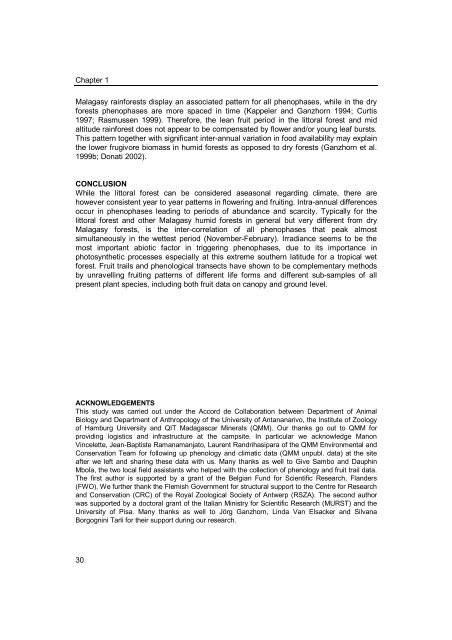Fruit-frugivore interactions in a Malagasy littoral forest - Universiteit ...
Fruit-frugivore interactions in a Malagasy littoral forest - Universiteit ...
Fruit-frugivore interactions in a Malagasy littoral forest - Universiteit ...
You also want an ePaper? Increase the reach of your titles
YUMPU automatically turns print PDFs into web optimized ePapers that Google loves.
Chapter 1<br />
<strong>Malagasy</strong> ra<strong>in</strong><strong>forest</strong>s display an associated pattern for all phenophases, while <strong>in</strong> the dry<br />
<strong>forest</strong>s phenophases are more spaced <strong>in</strong> time (Kappeler and Ganzhorn 1994; Curtis<br />
1997; Rasmussen 1999). Therefore, the lean fruit period <strong>in</strong> the <strong>littoral</strong> <strong>forest</strong> and mid<br />
altitude ra<strong>in</strong><strong>forest</strong> does not appear to be compensated by flower and/or young leaf bursts.<br />
This pattern together with significant <strong>in</strong>ter-annual variation <strong>in</strong> food availability may expla<strong>in</strong><br />
the lower <strong>frugivore</strong> biomass <strong>in</strong> humid <strong>forest</strong>s as opposed to dry <strong>forest</strong>s (Ganzhorn et al.<br />
1999b; Donati 2002).<br />
CONCLUSION<br />
While the <strong>littoral</strong> <strong>forest</strong> can be considered aseasonal regard<strong>in</strong>g climate, there are<br />
however consistent year to year patterns <strong>in</strong> flower<strong>in</strong>g and fruit<strong>in</strong>g. Intra-annual differences<br />
occur <strong>in</strong> phenophases lead<strong>in</strong>g to periods of abundance and scarcity. Typically for the<br />
<strong>littoral</strong> <strong>forest</strong> and other <strong>Malagasy</strong> humid <strong>forest</strong>s <strong>in</strong> general but very different from dry<br />
<strong>Malagasy</strong> <strong>forest</strong>s, is the <strong>in</strong>ter-correlation of all phenophases that peak almost<br />
simultaneously <strong>in</strong> the wettest period (November-February). Irradiance seems to be the<br />
most important abiotic factor <strong>in</strong> trigger<strong>in</strong>g phenophases, due to its importance <strong>in</strong><br />
photosynthetic processes especially at this extreme southern latitude for a tropical wet<br />
<strong>forest</strong>. <strong>Fruit</strong> trails and phenological transects have shown to be complementary methods<br />
by unravell<strong>in</strong>g fruit<strong>in</strong>g patterns of different life forms and different sub-samples of all<br />
present plant species, <strong>in</strong>clud<strong>in</strong>g both fruit data on canopy and ground level.<br />
ACKNOWLEDGEMENTS<br />
This study was carried out under the Accord de Collaboration between Department of Animal<br />
Biology and Department of Anthropology of the University of Antananarivo, the Institute of Zoology<br />
of Hamburg University and QIT Madagascar M<strong>in</strong>erals (QMM). Our thanks go out to QMM for<br />
provid<strong>in</strong>g logistics and <strong>in</strong>frastructure at the campsite. In particular we acknowledge Manon<br />
V<strong>in</strong>celette, Jean-Baptiste Ramanamanjato, Laurent Randrihasipara of the QMM Environmental and<br />
Conservation Team for follow<strong>in</strong>g up phenology and climatic data (QMM unpubl. data) at the site<br />
after we left and shar<strong>in</strong>g these data with us. Many thanks as well to Give Sambo and Dauph<strong>in</strong><br />
Mbola, the two local field assistants who helped with the collection of phenology and fruit trail data.<br />
The first author is supported by a grant of the Belgian Fund for Scientific Research, Flanders<br />
(FWO). We further thank the Flemish Government for structural support to the Centre for Research<br />
and Conservation (CRC) of the Royal Zoological Society of Antwerp (RSZA). The second author<br />
was supported by a doctoral grant of the Italian M<strong>in</strong>istry for Scientific Research (MURST) and the<br />
University of Pisa. Many thanks as well to Jörg Ganzhorn, L<strong>in</strong>da Van Elsacker and Silvana<br />
Borgogn<strong>in</strong>i Tarli for their support dur<strong>in</strong>g our research.<br />
30

















